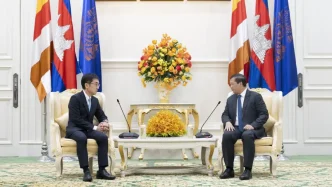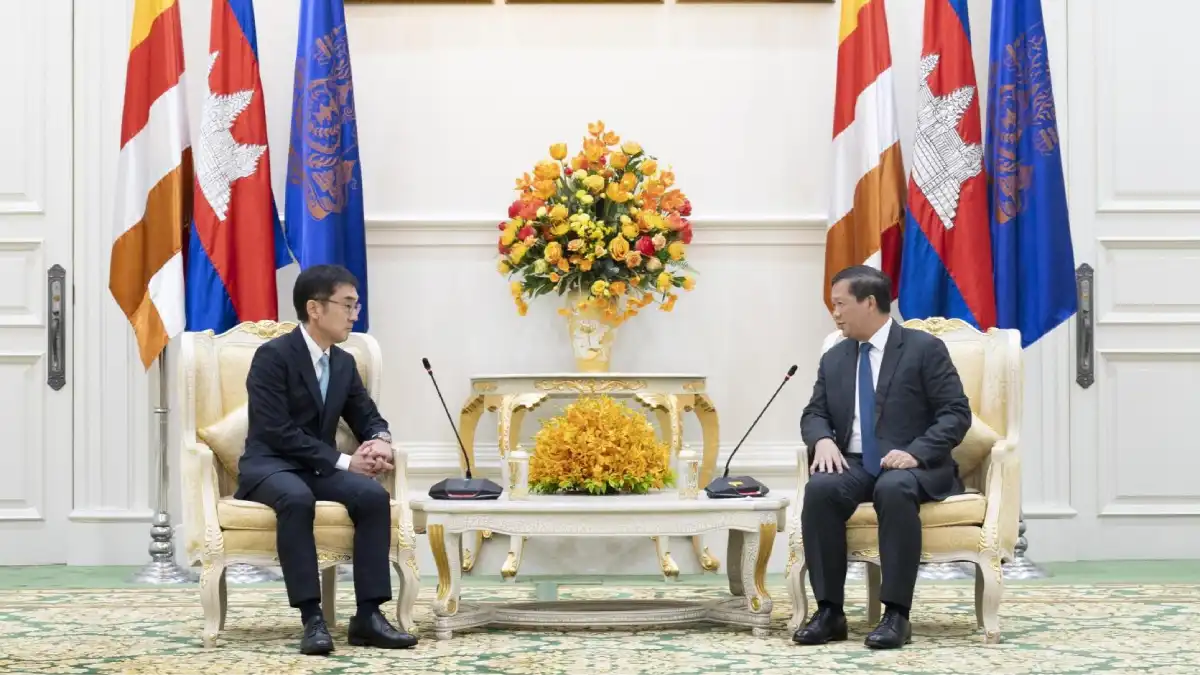Cambodian Prime Minister Hun Manet recently hosted a delegation of Malaysian business leaders in Phnom Penh, signaling a deepening economic partnership between the two Southeast Asian nations. The meeting, held on June 26, 2025, at the Peace Palace, underscored Cambodia’s growing appeal as an investment destination, with bilateral trade figures for the first five months of 2025 showing a robust 17.1% increase compared to the same period last year, reaching a total value of $429.27 million.
Led by Dato’ Sri Dr. Ricky Yaw, president of the Malaysia-Cambodia Business Association (MCBA), the delegation represented 20 Malaysian business associations keen to explore opportunities across diverse sectors, including education, healthcare, small and medium-sized enterprises (SMEs), agricultural processing, construction, and real estate. This visit marks a pivotal moment in Cambodia-Malaysia relations, as both countries seek to capitalize on regional economic integration and investor-friendly policies to drive mutual growth.
A Growing Economic Partnership
The economic relationship between Cambodia and Malaysia has seen significant progress in recent years. According to data from the General Department of Customs and Excise (GDCE), Cambodian exports to Malaysia in the first five months of 2025 totaled $57.52 million, up 5.7% from the previous year, while imports surged to $371.75 million, reflecting a 19.1% increase. This trade imbalance highlights Cambodia’s reliance on Malaysian goods, yet the overall growth in trade—17.1% year-on-year—demonstrates a strengthening bond. In 2024, total trade between the two nations reached $865.52 million, a striking 36.9% increase from the prior year, positioning Malaysia as Cambodia’s ninth-largest trading partner.
During the June 26 meeting, Prime Minister Hun Manet expressed satisfaction with the expanding connectivity between the two countries, citing the recent launch of direct flights between Phnom Penh and Penang by Cambodia Airways as a key development. He emphasized Cambodia’s welcoming stance toward foreign investors, particularly highlighting the government’s liberal investment laws and incentives tailored to support SMEs—a sector vital to the Kingdom’s economic fabric. “I encourage the Malaysia-Cambodia Business Association to continue deepening cooperation with Cambodian government institutions to gain a clearer understanding of policies and incentives, and to seize real investment opportunities directly in Cambodia” said Hun Manet.
Malaysian Interest in Cambodian Markets
Dato’ Sri Dr. Ricky Yaw, speaking on behalf of the Malaysian delegation, conveyed enthusiasm for direct engagement with Cambodia’s leadership. “The Malaysia-Cambodia Business Association was established as a platform to strengthen partnerships and connect businesspeople and investors from both countries” he said. Yaw noted that the delegation’s visit aimed to assess local conditions and identify viable investment prospects. Sectors such as education and healthcare, which are critical for Cambodia’s development, emerged as priority areas alongside traditional industries like construction and agricultural processing.
Real estate and SMEs also featured prominently in discussions, reflecting Cambodia’s ongoing urbanization and the government’s push to empower smaller businesses as engines of growth. Malaysian investors, with their expertise in these fields, could play a transformative role if partnerships are formalized. However, challenges such as regulatory clarity and infrastructure gaps may need to be addressed to ensure sustainable investments—a point likely to be explored in future dialogues between the two sides.
Strategic Agreements and Financial Innovation
Beyond the June meeting, recent agreements have laid the groundwork for enhanced cooperation. On May 6, 2025, the Cambodia Chamber of Commerce (CCC) and the Associated Chinese Chambers of Commerce and Industry of Malaysia (ACCCIM) signed a memorandum of understanding (MoU) at the CCC headquarters in Phnom Penh. This agreement aims to boost trade, investment, and private-sector collaboration, fostering closer ties between the business communities of both nations.
Additionally, a February 2024 MoU between the National Bank of Cambodia and Bank Negara Malaysia has paved the way for advancements in financial innovation and cross-border payment systems. This collaboration focuses on QR code-based transactions, which could streamline trade and benefit businesses and consumers alike by making payments more efficient and secure. Such initiatives align with broader regional efforts under frameworks like the Association of Southeast Asian Nations (ASEAN) to integrate financial systems and reduce transaction costs—a move that could further elevate Cambodia’s attractiveness to foreign investors.
Cambodia’s Investor-Friendly Environment
Cambodia’s economic strategy under Hun Manet’s leadership has prioritized creating a competitive environment for both regional and international markets. The government has rolled out measures to enhance the ease of doing business, including tax incentives and streamlined regulatory processes for foreign direct investment (FDI). SMEs, which account for a significant portion of Cambodia’s GDP and employment, have been a particular focus, with policies designed to provide access to financing and technical support.
For Malaysian investors, these policies present a dual opportunity: to tap into a growing market with a young, dynamic workforce and to contribute to Cambodia’s development goals. However, potential hurdles remain. While Cambodia has made strides in improving its business climate, issues such as bureaucratic inefficiencies and limited infrastructure in rural areas could pose risks. If addressed through sustained government reforms and public-private partnerships, these challenges could be mitigated, paving the way for deeper Malaysian engagement.
Regional Context and ASEAN Integration
The Cambodia-Malaysia economic partnership must also be viewed through the lens of ASEAN’s broader integration agenda. Both countries are active members of the regional bloc, which prioritizes economic cooperation through initiatives like the ASEAN Economic Community (AEC). The AEC aims to create a single market and production base, facilitating the free flow of goods, services, and investments. For Cambodia, attracting investment from neighbors like Malaysia is a step toward achieving these goals, while for Malaysia, Cambodia offers a gateway to less saturated markets within the Mekong subregion.
Trade figures underscore the potential for further growth. The $865.52 million in total trade for 2024, with a 36.9% year-on-year increase, suggests that both nations are on an upward trajectory. Yet, the disparity between Cambodia’s exports ($147.39 million) and imports ($718.13 million) from Malaysia indicates room for Cambodian industries to scale up production and diversify offerings. Agricultural processing, one of the sectors highlighted by the Malaysian delegation, could be a starting point, leveraging Cambodia’s abundant natural resources and labor force.
Challenges and Opportunities Ahead
While the outlook for Cambodia-Malaysia economic ties appears promising, several factors could shape the pace of progress. For Malaysian investors, navigating Cambodia’s legal and regulatory landscape will be critical. Although the government has introduced investor-friendly policies, transparency and enforcement remain areas of concern for some foreign entities. Ensuring that incentives are accessible and consistently applied could bolster confidence among potential investors.
On the Cambodian side, balancing foreign investment with domestic priorities is essential. While FDI can drive growth, over-reliance on external capital without strengthening local industries could create vulnerabilities. Hun Manet’s administration appears aware of this, as evidenced by its focus on SMEs and competitiveness. If successful, these efforts could position Cambodia as a regional hub for investment, rivaling more established ASEAN economies.
Public Sentiment and Future Prospects
Public reaction to the growing Cambodia-Malaysia partnership has been largely positive, with local business leaders and communities hopeful that new investments will create jobs and improve infrastructure. However, some caution that benefits must be equitably distributed to avoid exacerbating income inequality—a persistent issue in Cambodia’s rapid development. Engaging local stakeholders and ensuring transparency in investment deals will be key to maintaining public support.
As both nations build on recent agreements and high-level engagements, the trajectory of their economic relationship will likely hinge on sustained dialogue and tangible outcomes. With trade figures trending upward and mutual interest in diverse sectors, the foundation for a stronger partnership is in place. Whether this translates into transformative investments and shared prosperity remains an open question, one that policymakers and business leaders on both sides will need to address in the months ahead.
















